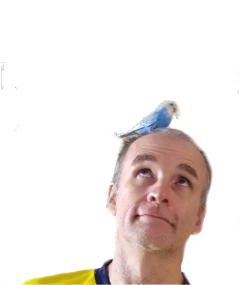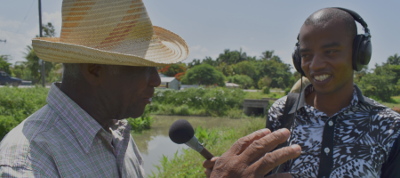Writing for radio: a quote-based writing method
Nov. 8, 2018
Writing can be hard. You often start by staring into space, trying to drag words out of an abstract void. The beauty of radio is that your interviewees do most of the talking. The quotes you extract from your interviews are a grab bag of concrete material to work with. By focusing on those quotes instead of your own words you can get three-quarters of the way to a finished script without writing a thing.
Interviewing
Writing begins in the field. Get your interviewees to tell your story for you.
- Get as much audio as possible. A good rule of thumb is 60 minutes of recording per one minute of airtime. A 10 minute piece requires about 10 hours of recording. That's flexible though and depends on the quality of your interviews.
- Get your participants to tell a story about themselves. This means you need to win their confidence. You have to ask questions that take them back in time and go beyond the immediate subject matter. Be alert to emotions or events that could inspire emotion. People don't always want to talk about these matters. Sometimes they don't think anyone would be interested. Let them feel like you are offering them a platform to share something important.
- Look out for interesting ambient sound and record lots of it, 30 to 60 seconds for each sound.
Reviewing the audio
Everyone hates transcribing, but it's the best way to get to know your material.
- Transcribe or at least log all of your audio. Listen to every minute of it. As you are listening, take a note of anything that seems interesting to you. It doesn't matter if it relates to the topic of the report or not. Look out for anything that piques your interest and perks your ears. This could be quotes or passages that express emotion, demonstrate personality, use unusual wording, tell a joke, insult, make a controversial statement, or contain striking facts. Think of your quotes like music. If a catchy rhythm comes on some radio playing in the background, you pay attention. Good quotes can have the same effect.
- Write a very brief summary of each quote, just enough to remind you of what it was, even if it's only one word. ("Laughs"). Note the time the quote begins in the audio track.
- Ambient sound is a key part of telling your story. Note ambient sound exactly the same way. ("Car drives by honking.")
- You should now have a big catalog of quotes.
Plotting the story
Don't try and figure out the story in your head. Let the quotes show you where the story goes.
- Before even thinking about the "story", just think about which quotes from your catalog you want to put into the piece. These might be quotes that contain relevant information for the report, but they might also be quotes that sound good, interesting, moving: an infectious laugh for example, a witty observation, even a strong piece of ambient audio. If you've got a really strong quote, the story will build itself around that.
- Now think about which quotes go together. Some quotes will form natural sequences or scenes: for example several clips of a person telling an anecdote. Some quotes will share a theme: you can string together more than one voice all offering slightly different perspectives or angles on a single subject. Others might form a natural transition: a politician makes an argument or assertion, followed by a person whose life experience contradicts that assertion. Some quotes might not fit into any scene, but are so important that they will somehow have to stand alone.
- Now think about your characters as seen through the quotes. You might have interviewed seven people, but only one or two stand out as being really interesting. These are the people you want your listener to get to know. Generally your report will contain more than one quote from these people. Some of their quotes may just give a sense of their personality, without any relevance to the subject of the report. Others may speak about different aspects of the subject, or reveal different stages in a personal story related to the subject. Whatever the case, it is important that the quotes reveal something about their lives or their personality. You don't need a lot. This isn't Shakespeare. But you do something idiosyncratic that makes them more than just a voice on the street in the minds of your listeners.
- Now think about how to order those clusters of quotes into scenes in a way that very broadly outlines a story. This isn't a story in the traditional sense of "This happened and then this happened and then this happened." Think of your report as telling the story of an issue or topic. You reveal the issue little-by-little, drawing your listener in, presenting some kind of problem, reaching a crisis in the problem and then resolving the problem, either happily or unhappily. If you found the right interviewees, then their personal stories can be used as a framework for the larger story of the issue. If not, you can still piece the story of the issue together by compiling quotes from different interviewees. At this point, you still don't need to be able to define the story in words. It is just enough to think about the natural order of your quotes. A very simplistic ordering might go something like this:
- scene rich in ambient audio and personality quotes that present your characters
- series of quotes where the characters explain some kind of problem
- expert who generalizes the problem and puts it in context
- scene from the place where the problem arose, with quotes from witnesses or people involved
- more from the main characters who give more detail
- controversial quote from someone who denies the problem
- rebuttal from the expert
- return to the original scene where the main characters make some forward-looking observation
Time to write
If you've got the story plotted out with your quotes, your own words are just the glue that holds them together.
- Only once you have the order of the quotes and scenes decided, then start writing. Write narration that will fit between each quote. You will need to introduce characters, describe scene locations, explain the principal problem, summarize the denser facts and statistics and generally fill in missing details.
- Each segment of narration shouldn't last more than a minute (30 seconds preferably). You want to rely on your quotes as much as possible to move the story along. Likewise, you don't want any single quote to be more than a minute. In my experience, a ten minute piece will use about 20 quotes and ambient sound, and 20 segments of narration.
- Be prepared to change things. It is rare that the story will follow the outline you created in the last section exactly. But at least it got you started.



